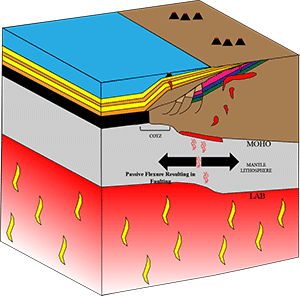Model #3: Lithospheric Extension Model
 This model proposes no mantle source for the initial pulse of magmatism, and that it was a response to the deformation of the overlying lithosphere; the asthenosphere merely moved in to occupy space vacated by the lithosphere. Post rift areas that experienced high degrees of extension during rifting could not support the increased sedimentary load during Cretaceous times and subsided, while regions like the Sabine Uplift that had undergone less extension, where stronger, in turn rose and became the new topographic highs. The area would be most weakened through extension and the following brittle deformation would be the transition zone between the continental and oceanic crust at the suture zone (see accompanying model). The magma then simply followed the path of least resistance adjacent to the sutures. No concern to the composition and overall nature of the magmas themselves are addressed in this model, but reactivation of basement structures most likely played some part in the geographical distribution of the igneous bodies.
This model proposes no mantle source for the initial pulse of magmatism, and that it was a response to the deformation of the overlying lithosphere; the asthenosphere merely moved in to occupy space vacated by the lithosphere. Post rift areas that experienced high degrees of extension during rifting could not support the increased sedimentary load during Cretaceous times and subsided, while regions like the Sabine Uplift that had undergone less extension, where stronger, in turn rose and became the new topographic highs. The area would be most weakened through extension and the following brittle deformation would be the transition zone between the continental and oceanic crust at the suture zone (see accompanying model). The magma then simply followed the path of least resistance adjacent to the sutures. No concern to the composition and overall nature of the magmas themselves are addressed in this model, but reactivation of basement structures most likely played some part in the geographical distribution of the igneous bodies.

